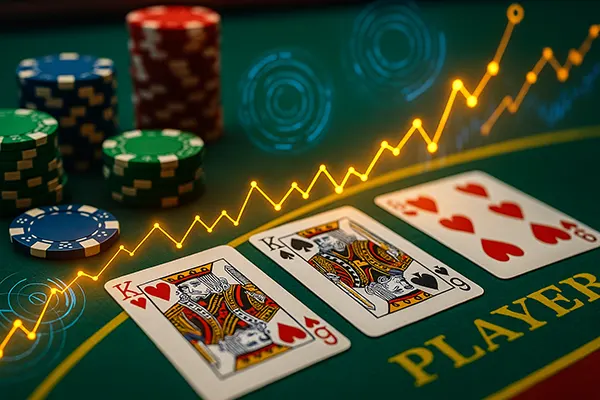
Modern Algorithms and AI Tools for Analysing Baccarat Outcomes: Are They Worth Attention?
Baccarat has long been regarded as a game of chance, where outcomes are determined by shuffled decks rather than player skill. Yet, in 2025 the integration of advanced algorithms and artificial intelligence tools has introduced new ways of approaching the game. These technologies promise deeper insights, trend detection and statistical clarity. The question that remains is whether they truly offer players any tangible advantage or if they simply provide another layer of analysis without altering the fundamental odds.
The Role of Algorithms in Baccarat Analysis
Algorithms are designed to recognise patterns and evaluate sequences of outcomes. In baccarat, players often search for streaks of banker or player wins, and algorithms can process thousands of historical results to identify whether such patterns hold statistical weight. While these tools cannot change the randomness of the game, they allow enthusiasts to examine probabilities in a more structured way.
One of the key developments has been the use of Monte Carlo simulations. These replicate countless rounds of baccarat to predict long-term statistical distributions. The outcomes highlight that the banker bet maintains a small house edge, proving why it is often considered the most statistically reliable option. By providing clear, numerical evidence, algorithms demystify some of the myths surrounding strategy.
Another notable aspect is the integration of probability models into live baccarat analysis tools. These models generate real-time win expectancy data, helping users to better understand how far the results deviate from theoretical probabilities. Such insights can serve as a reality check for players who may otherwise be guided by intuition alone.
Strengths and Limitations of Algorithmic Insights
The primary strength of algorithms lies in their capacity to remove subjectivity. Players often believe in so-called “hot streaks,” but algorithms highlight that randomness does not bend to patterns. This provides a more grounded perspective, particularly for those who rely heavily on trend-following strategies.
On the other hand, algorithms cannot predict future outcomes with certainty. No matter how refined the model is, baccarat remains tied to random number generation or physical shuffling. While algorithms can confirm statistical tendencies, they cannot grant predictive foresight. This limitation must be clearly understood to prevent false expectations.
Moreover, accessibility has become a factor. Many commercial analysis tools are embedded in third-party applications or subscription services. Their utility may be more valuable to researchers and data enthusiasts than to casual players, raising the question of whether they truly influence decision-making during live play.
Artificial Intelligence in Baccarat Analytics
Artificial intelligence takes algorithmic analysis further by applying machine learning and deep learning techniques. Instead of solely evaluating probabilities, AI models attempt to forecast behaviour based on massive datasets. These systems can recognise betting tendencies across different players and simulate how patterns emerge in live gaming sessions.
In recent years, AI has been deployed in developing “smart dashboards” for baccarat. These dashboards process streams of results and provide visual representations of potential outcome distributions. Unlike static probability charts, they adjust dynamically to new data, offering a more interactive analytical experience for players and researchers alike.
Some AI-driven tools also incorporate natural language processing, allowing users to query game statistics through conversational interfaces. This bridges the gap between technical complexity and user accessibility, ensuring that players with minimal mathematical knowledge can still interpret results effectively.
Evaluating the Practical Use of AI Tools
AI-driven analytics are most valuable when used to observe long-term statistical behaviours. They can highlight when outcomes deviate significantly from expected probabilities, which may interest casino regulators and fairness auditors as much as individual players. This broader application strengthens the reliability of baccarat as a regulated game.
For players, however, AI remains more of an informational companion than a tactical advantage. The ability to forecast shifts in randomness is limited, and AI cannot bypass the underlying house edge built into baccarat. What it can do is empower individuals to make informed choices based on accurate statistical contexts rather than emotional decisions.
Additionally, AI tools often serve educational purposes. By visualising randomness in action, they help dismantle misconceptions around “beating the system.” In doing so, they contribute to more responsible gambling practices and reduce the appeal of superstition-driven betting patterns.

The Future of Data-Driven Baccarat Analysis
Looking ahead, the role of data science and artificial intelligence in baccarat will continue to expand. Casinos themselves already employ algorithms to monitor player behaviour, detect irregularities and ensure fairness. For the wider gambling community, these technologies are becoming valuable for research, transparency, and understanding statistical realities.
In 2025, one of the promising directions is the integration of blockchain technology with baccarat analytics. By recording game outcomes on transparent ledgers, analysts and players alike gain greater confidence in the legitimacy of results. When combined with AI, this creates an ecosystem where fairness and analytical depth coexist.
Another area of growth lies in responsible gambling initiatives. Predictive AI models are increasingly capable of detecting problematic betting patterns, issuing alerts to players, and supporting intervention strategies. In this way, algorithms and AI tools serve not just as analytical devices but also as guardians of sustainable play.
Should Players Pay Attention?
The final consideration is whether these tools are worth the attention of everyday players. For enthusiasts seeking deeper understanding of probabilities, the answer is yes—algorithms and AI provide clarity and context that raw gameplay cannot. They transform baccarat from a purely intuitive game into a subject of statistical exploration.
However, those expecting a guaranteed edge should be cautious. No AI system can alter the fact that baccarat is a game structured to maintain a house advantage. Analytical tools may refine understanding but do not rewrite mathematics. The ultimate decision lies in how players choose to use the information available.
In essence, algorithms and AI instruments enrich the discourse around baccarat without altering its foundation. They invite players to engage more critically, but they do not overturn the balance of chance and probability that defines the game itself.
